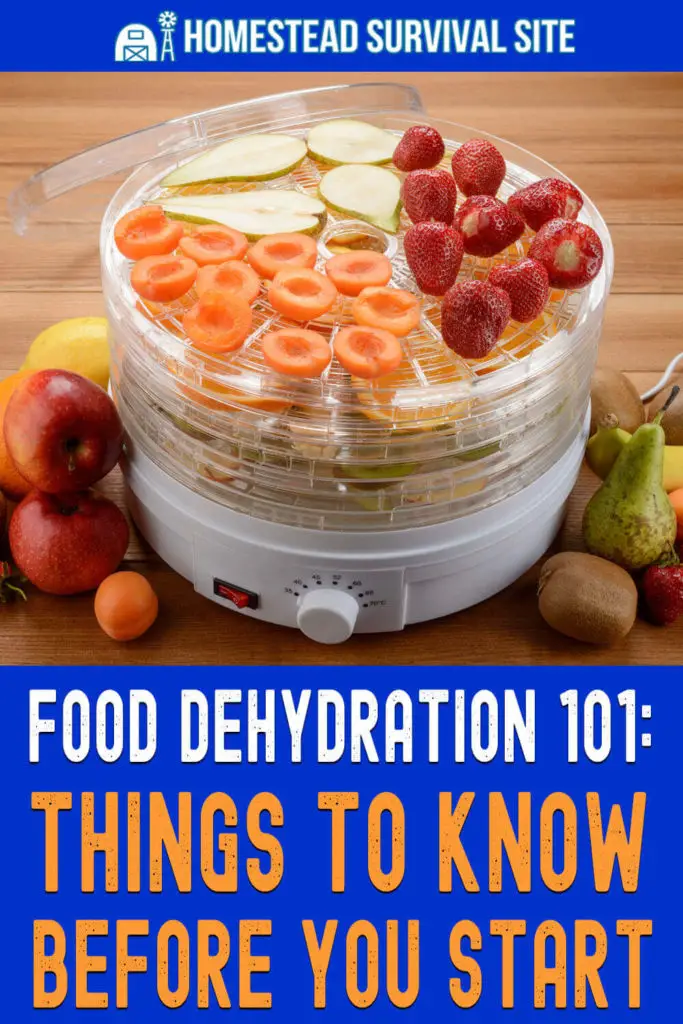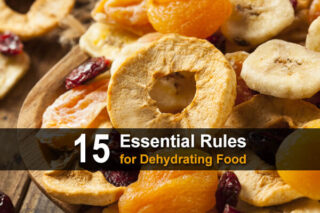Estimated reading time: 7 minutes
One of the best ways to preserve food is to dehydrate or dry the food for storage. Civilizations have been doing this for years, and it is not only economical but also a great way to save fresh fruit harvested today for your meals in the future. Dried food doesn’t mold, rot and can last decades depending on the method used to preserve it.
The most important thing to know about dehydrating is that it is a slow process at lower temperatures. Keeping the temperature low allows the food to release moisture without cooking it in the process. While drying food may seem like an easy process, there are some tips and tricks that could help you get started. Here are some things you must know before dehydrating food.
Want to save this post for later? Click Here to Pin It On Pinterest!
Different Dehydrating Methods
While many of us may only think that food is dehydrated using a countertop plug-in device, there are various ways to dehydrate your food based on what you have available to you.
Sunlight
As the oldest way to dehydrate food, the sun offers an excellent heat source. Dried fruit like peaches, pears, raisins, and figs are easy examples of how the sun can remove the moisture content from food.
However, dehydration by sunlight does pose some problems. First, you’ll need to ensure that the temperature is hot enough, around 86°F and that the humidity is about 60%. It is also essential to cover the food to protect it from bugs and animals while still providing a way for moisture to escape. Drying by sunlight takes many days as well, making it less of an efficient option.
Air
Another old way to dry food is to hang it up to allow the air to remove moisture. This is often done for foods that can be hung in thin strips to reduce the drying time. You can also use a drying net.
Air drying is an excellent fit for those leafy greens or plants that don’t need any protection from predators. You can dry fish and meat through air drying, but it can get tricky with keeping predators away and making sure the meat doesn’t spoil in the process.
Dehydrator
Many homesteaders use a dehydrator to help speed up the drying process. You can purchase a traditional plastic dehydrator that is circular in shape and comes with stackable trays. There are also high-end dehydrators that use metal trays and are usually a square shape.
Commercial versions come with programming options, while the older round style is less high-tech. All of these versions run off of electricity, making them less optimal for those living off-grid.
Oven
Using your oven as a low heat source is also an option for dehydrating food. Make sure to check your oven to see if it even has a low heat source option. Since dehydration should happen at around 140°F, some ovens may not provide a low enough heat option. Higher-end ovens may have a dehydrating option, though, so double-check your oven to see if it will work.
Freeze Dry
While freeze-drying is different from typical dehydration methods, it does remove the moisture from food, making it shelf-stable. A few freeze drier options are available for home use, but they cost a pretty penny. Freeze drying food uses extremely cold temperatures to freeze the moisture within the food, then uses a vacuum to suck out the moisture.
Different Kinds of Foods
While you can dehydrate almost any fresh food available, some don’t hold up well to this preservation method. There are also some foods that respond well to dehydration.

Fruits and Vegetables
For those who are new to dehydrating, the obvious choice to try out first is fruit and vegetables. Removing the water from strawberries, bananas, and apples is often a no-brainer. These items are prevalent in stores and usually purchased in a dried format as well. Vegetables that work well include peas, carrots, and onions that are great to add to stews and soups.
Herbs
Another great way to practice dehydrating is to select a few herbs from the garden. Herbs are quicker to dry out and are less expensive to replace if something goes wrong. You can often air dry herbs, making them easy to dehydrate and add them to the spice rack. Many homesteaders gather small bundles of herbs and then hang them upside down in the kitchen to dry out.
Meat
Beef jerky is another great way to preserve meat in a shelf-stable way. You can dehydrate meat in multiple forms, including sliced, ground, cured, and fresh. There is always an element of caution when dehydrating meat, as you don’t want to get sick due to spoiled or partially dried meat. It is also best to dry meat that is already cooked.
Other Foods
Some people dry nuts to make them easier to consume while others may try dehydrating crackers or bread. Try experimenting with different kinds of food to see what works best for you.
Special Preparations
While dehydrating food is relatively easy, there are some special circumstances and skills to learn.
Acid Dips
Some people like to keep the color and flavor of their food as much intact as possible. While the dehydration process does remove some of the aesthetic and taste aspects of food, it is possible to help prevent this loss. You can dip food slices into ascorbic acid to help preserve the original color and flavor. Other dip options include citric acid, sodium bisulfite, and fruit juice.
Air Flow
An important part of dehydrating any kind of food is to encourage airflow. Food should sit on perforated plates, trays, or screens to help move air around the food. Without a way for the air to escape, you’ll end up steaming the food and keeping the unwanted moisture trapped.
Blanching
While it isn’t necessarily required, some people blanch those items that will take longer to dry. These are often root vegetables that stand up well to the blanching process. It also helps lock in flavor before dehydrating, which could be a world of difference in taste.
Puree
Some foods that break down easily may be harder to dehydrate. Delicate foods may do better in puree form before drying. Berries are particularly easier to handle when pureed first to create a natural fruit rollup. Many dehydrator options offer smooth drying racks for this purpose, to pour a puree into that is easy to peel off.
Temperature and Time
Foods have different temperature and drying time requirements based on what they are and the kind of drying method in use. Drying times can also greatly differ depending on the shape and thickness of the food. However, here are some general guidelines for drying times for each food group:
- Fruits
- Drying Time: 6-36 Hours
- Drying Temperature: 135°F-145°F
- Herbs
- Drying Time: 2-4 Hours
- Drying Temperature: 95°F-105°F
- Meat & Fish
- Drying Time: 6-12 Hours
- Drying Temperature: 145°F-160°F
- Vegetables
- Drying Time: 4-10 Hours
- Drying Temperature: 125°F-145°F
No matter what kind of dehydration method you choose, dehydrating your food is a great way to preserve it for consumption down the road. It can be a fun and tasty way to store food and promotes a healthy lifestyle as most food is natural. Make sure you know these things before dehydrating food so you can create beautiful and delicious preserved food for your home.
Like this post? Don't Forget to Pin It On Pinterest!












